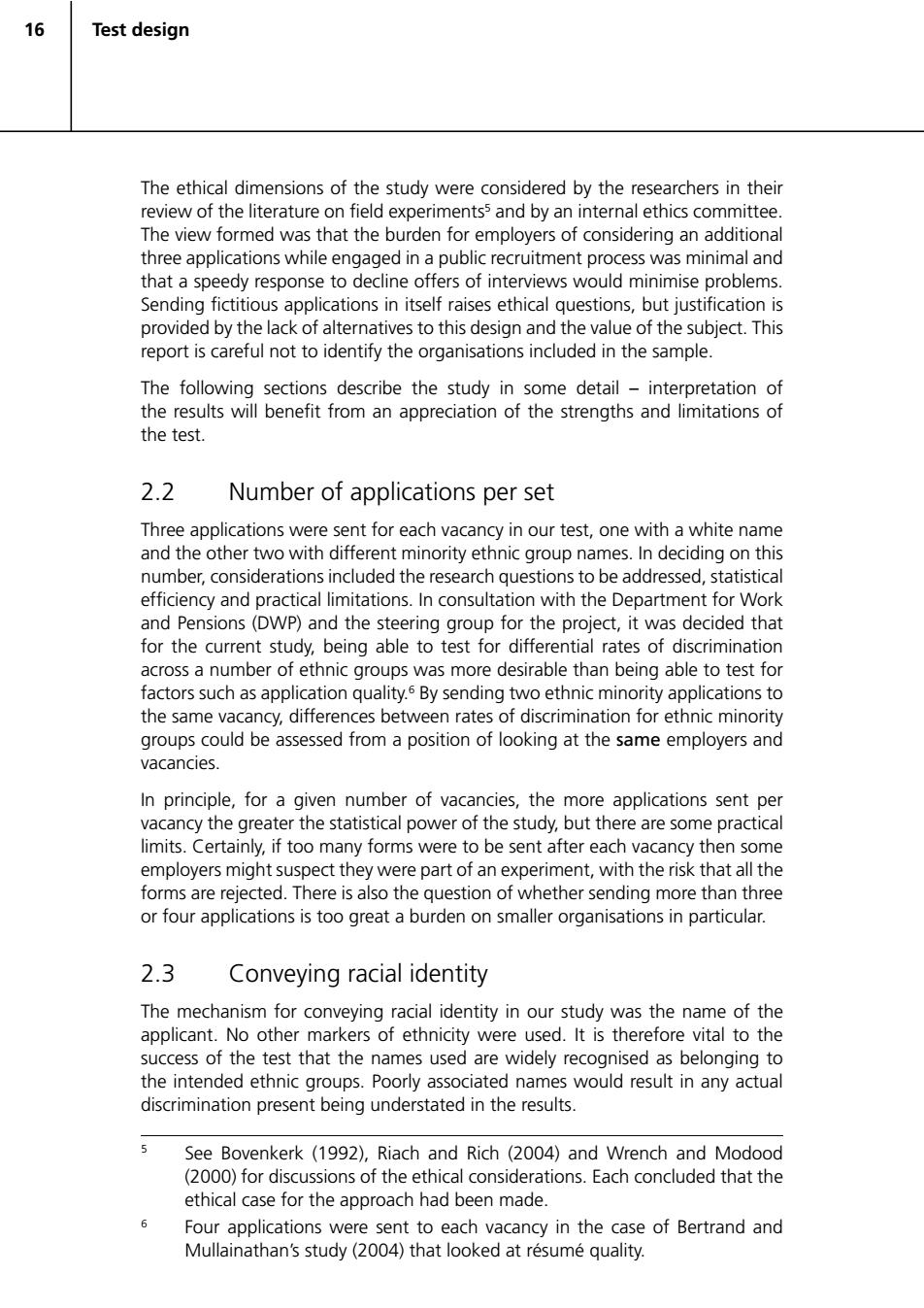正在加载图片...

16 Test design The ethical dimensions of the study were considered by the researchers in their review of the literature on field experiments5 and by an internal ethics committee. The view formed was that the burden for employers of considering an additional three applications while engaged in a public recruitment process was minimal and that a speedy response to decline offers of interviews would minimise problems. Sending fictitious applications in itself raises ethical questions,but justification is provided by the lack of alternatives to this design and the value of the subject.This report is careful not to identify the organisations included in the sample. The following sections describe the study in some detail -interpretation of the results will benefit from an appreciation of the strengths and limitations of the test. 2.2 Number of applications per set Three applications were sent for each vacancy in our test,one with a white name and the other two with different minority ethnic group names.In deciding on this number,considerations included the research questions to be addressed,statistical efficiency and practical limitations.In consultation with the Department for Work and Pensions(DWP)and the steering group for the project,it was decided that for the current study,being able to test for differential rates of discrimination across a number of ethnic groups was more desirable than being able to test for factors such as application quality.6 By sending two ethnic minority applications to the same vacancy,differences between rates of discrimination for ethnic minority groups could be assessed from a position of looking at the same employers and vacancies. In principle,for a given number of vacancies,the more applications sent per vacancy the greater the statistical power of the study,but there are some practical limits.Certainly,if too many forms were to be sent after each vacancy then some employers might suspect they were part of an experiment,with the risk that all the forms are rejected.There is also the question of whether sending more than three or four applications is too great a burden on smaller organisations in particular. 2.3 Conveying racial identity The mechanism for conveying racial identity in our study was the name of the applicant.No other markers of ethnicity were used.It is therefore vital to the success of the test that the names used are widely recognised as belonging to the intended ethnic groups.Poorly associated names would result in any actual discrimination present being understated in the results. 5 See Bovenkerk (1992),Riach and Rich (2004)and Wrench and Modood (2000)for discussions of the ethical considerations.Each concluded that the ethical case for the approach had been made. Four applications were sent to each vacancy in the case of Bertrand and Mullainathan's study(2004)that looked at resume quality.16 The ethical dimensions of the study were considered by the researchers in their review of the literature on field experiments5 and by an internal ethics committee. The view formed was that the burden for employers of considering an additional three applications while engaged in a public recruitment process was minimal and that a speedy response to decline offers of interviews would minimise problems. Sending fictitious applications in itself raises ethical questions, but justification is provided by the lack of alternatives to this design and the value of the subject. This report is careful not to identify the organisations included in the sample. The following sections describe the study in some detail – interpretation of the results will benefit from an appreciation of the strengths and limitations of the test. 2.2 Number of applications per set Three applications were sent for each vacancy in our test, one with a white name and the other two with different minority ethnic group names. In deciding on this number, considerations included the research questions to be addressed, statistical efficiency and practical limitations. In consultation with the Department for Work and Pensions (DWP) and the steering group for the project, it was decided that for the current study, being able to test for differential rates of discrimination across a number of ethnic groups was more desirable than being able to test for factors such as application quality.6 By sending two ethnic minority applications to the same vacancy, differences between rates of discrimination for ethnic minority groups could be assessed from a position of looking at the same employers and vacancies. In principle, for a given number of vacancies, the more applications sent per vacancy the greater the statistical power of the study, but there are some practical limits. Certainly, if too many forms were to be sent after each vacancy then some employers might suspect they were part of an experiment, with the risk that all the forms are rejected. There is also the question of whether sending more than three or four applications is too great a burden on smaller organisations in particular. 2.3 Conveying racial identity The mechanism for conveying racial identity in our study was the name of the applicant. No other markers of ethnicity were used. It is therefore vital to the success of the test that the names used are widely recognised as belonging to the intended ethnic groups. Poorly associated names would result in any actual discrimination present being understated in the results. 5 See Bovenkerk (1992), Riach and Rich (2004) and Wrench and Modood (2000) for discussions of the ethical considerations. Each concluded that the ethical case for the approach had been made. 6 Four applications were sent to each vacancy in the case of Bertrand and Mullainathan’s study (2004) that looked at résumé quality. Test design